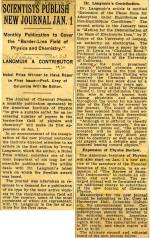|
The powerful concept of resonance was now entering its full flower. The sixth in Pauling's
chemical bond series, written in 1933 with postdoctoral fellow Jack Sherman, extended
the concept to more chemical puzzles involving variations from classical single, double,
and triple bonds. This work, too, was groundbreaking.
In "The Nature of the Chemical Bond VI. The calculation from the thermochemical data
of the energy of resonance of molecules among several electronic structures" Pauling
showed that molecules were not restricted to whole-integer links (the classic single,
double and triple bonds) but could take on intermediate forms. Here again he melded
the bond lengths and strengths from his ever-growing library of molecular structures
with his ideas about the stabilizing influence of resonance, and came up with novel
explanations for a whole slew of problems.
This was particularly important for structural chemistry. Atoms connected by single
bonds were known to be able to rotate like wheels on an axle, for instance, while
those linked by double and triple bonds were held rigidly and double bonds — with
what he called "partial double-bond character" — were also restricted from rotating,
an important factor in focusing the approach to potential structures and predicting
new ones. In his sixth paper Pauling explained the restriction on rotation in quantum-mechanical
terms, then applied his idea of resonance between single and double bonds to explain
the bond lengths and rotational properties of a number of intermediate cases.
|
|
Click images to enlarge

"Scientists Publish New Journal Jan. 1." December 23, 1932.

"The nature of the chemical bond. VI. The calculation from thermochemical data of
the energy of resonance of molecules among several electronic structures." April 13, 1933.
"I published a paper with Jack Sherman on the calculation of some of these overlap
integrals with a simplification.... It's in The Nature of the Chemical Bond, the results are -- with a simplification of some sort; it's like taking Slater functions,
I don't know what it was, but actually evaluating the overlap integrals. Our conclusion
was that the bond strength function giving angular dependence alone is really pretty
good -- not perfect but pretty good."
|

